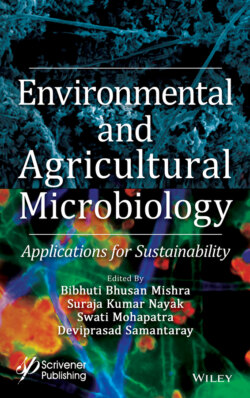Читать книгу Environmental and Agricultural Microbiology - Группа авторов - Страница 64
3.5.3 Biovolatilization
ОглавлениеThe transformation of metals by microbes into their volatile forms is known as bio-volatilization and contributes in the alteration of metal from soluble state to gaseous state. This biovolatilization process can remove metal from solid phase by utilizing microbes. Therefore, this process can be applied for both wastewater treatment and solid waste treatment. If the gas form of volatilized metals can trick from wastewater treatment method, they can be consequently recovered [72]. The metals commonly connected with their methylation and alkylation of biovolatilization method by microbes, whereas volatilization of mercury and arsenic may also be facilitated by their removal [72, 73]. Biovolatilization is a common method for mercury and arsenic in environment through which detoxification approaches applied on soil and water based on transformation of highly toxic compound to nontoxic or less toxic compound and highly volatile for removal of metals (Figure 3.4) [73].
Figure 3.4 Mechanism of biovolatilization.
In contaminated environment, bacteria developed resistance resulting due to the aforesaid mechanism which further leads to mercury detoxification. The reductase enzyme (Mercury(II)reductase) of the bacteria causes a reduction of Hg2+ to nontoxic Hg0, and hence, a diffusional loss of Hg0 from bacterial cell takes place. The mercuric reductase coded by merA gene is important for reduction of inorganic Hg while cytosolic mercuric lyase enzymes coded by merB gene breaks the C-Hg bond of most organomercury [69]. Earlier studies reported that bacteria involved in this mechanism and resistance to Hg such as Bacillus sp., Pseudomonas sp., Psychrobacter sp., Halmonas sp., Luteimonas sp., and Micrococcus sp. are isolated from highly polluted area [74]. The elemental mercury is highly volatile and the gas phase needs some special treatment to immobilize it. The Hg0 produced by volatilization and it is removed into gas phase by fast oxidative absorption process and recovered. This technique can be applied on soil, wastewater, and sediment [69].
The biovolatilization process also involve in arsenic removal from contaminated soil and water. In soil, arsenic could be converted into volatile byproducts and removed. Both aerobic and anaerobic microorganisms are involved in the evolution of volatile arsenicals. The volatilization of arsenic by microorganisms depends upon several factors like arsenic compound, concentration, and moisture of soil, organic materials, temperature, other similar components, growth of microbes, and ability of volatilization of arsenic. Biovolatilization of arsenic is by lessening of As(V) to As(III) with end product of TMAs. Currently, Escherichia coli have expressed arsenite S-adenosylmethionine methyltransferase gene (arsM), which is cloned from Rhodopseudomonas palustris and is capable to form methylate inorganic arsenic to TMA volatile form. In indigenous bacteria, arsM gene has capability to remove As through volatilization from soil. The strains express arsM gene in aquatic system such as Sphingomonas desiccabilis and Bacillus idriensis. The arsenic resistant bacteria can express arsM gene for biovolatilization of arsenic and these bacteria can engineered under laboratory condition to apply in aquatic and soil environment [73].
